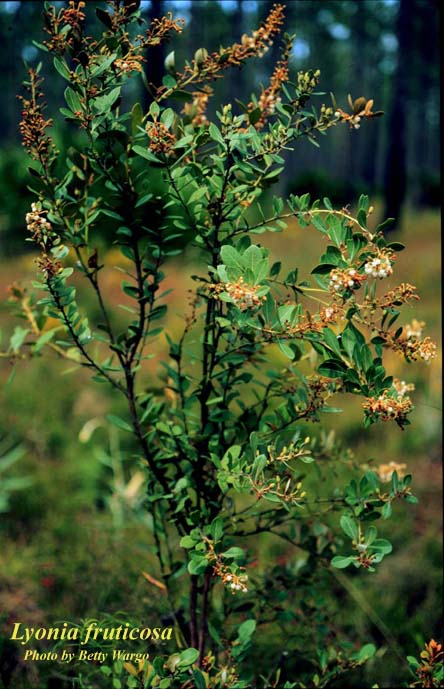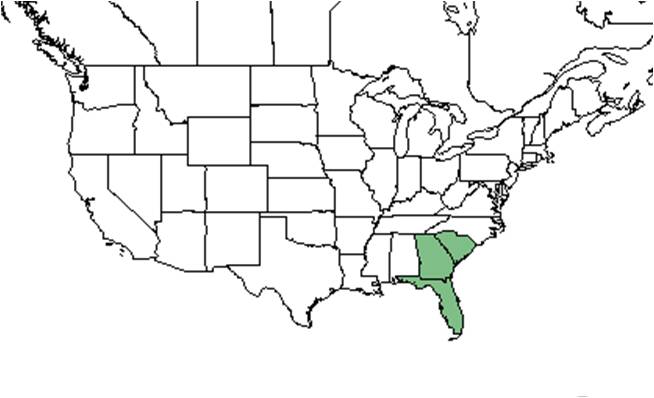Lyonia fruticosa
| Lyonia fruticosa | |
|---|---|

| |
| Photo by Betty Wargo, Atlas of Florida Vascular Plants | |
| Scientific classification | |
| Kingdom: | Plantae |
| Division: | Magnoliophyta - Flowering plants |
| Class: | Magnoliopsida – Dicotyledons |
| Order: | Ericales |
| Family: | Ericaceae |
| Genus: | Lyonia |
| Species: | L. fruticosa |
| Binomial name | |
| Lyonia fruticosa (Michx.) G.S. Torr. | |

| |
| Natural range of Lyonia fruticosa from USDA NRCS Plants Database. | |
Common name: coastal plain staggerbush
Contents
Taxonomic notes
The genus Lyonia is named for John Lyon a 19th century botanist who is best known for his travels in southern Appalachians [1].
Description
A description of Lyonia fruticosa is provided in The Flora of North America.
It is very similar to L. ferruginea however, L. fruticosa has scales on the abaxial side that are all the same size [2].
Distribution
It can be found in the extreme southern part of South Carolina, southern Georgia, and Florida [3].
Ecology
Habitat
Habitats of L. fruticosa include pine flatwoods, pine-oak scrubs, pine/saw palmetto flats, Cyrilla swamps, cypress-gum swamps, shrub bogs, upland xeric sand pine/sand live oak communities, depression marshes, shore hammock, and mesic hardwood hammocks. It has been observed growing in abandoned dumps and slash pine plantations. Substrates include loamy sand and white sand. Associated species include Lyonia lucida, Ilex glabra, Myrica cerifera, Aronia, Sarracenia minor, Rhododendron, Kalmia, Hypericum, Serenoa repens, Agalinis and Sphagnum (FSU Herbarium; Schmalzer and Hinkle 1992).
Phenology
The white urn-shaped flowers and dry, egg shaped fruits appear March through December [3](FSU Herbarium).
Seed dispersal
Seed bank and germination
Fire ecology
L. fruticosa recovers post-fire from resprouting and clonal growth (Menges and Maguire 2011) and shows a significant positive trend in percent frequency with time since last fire in rosemary scrubs (Menges and Kohfeldt). Density is the highest 12 months post burn (Schmalzer and Hinkle 1992).
Pollination
The following Hymenoptera families and species were observed visiting flowers of Lyonia fruticosa at Archbold Biological Station (Deyrup 2015):
Apidae: Bombus impatiens
Colletidae: Colletes banksi, C. distinctus, C. productus, C. sp. A
Halictidae: Augochloropsis sumptuosa
Sphecidae: Stictia carolina
Vespidae: Monobia quadridens
Use by animals
Diseases and parasites
Conservation and Management
Cultivation and restoration
Photo Gallery
References and notes
Deyrup, M.A. and N.D. 2015. Database of observations of Hymenoptera visitations to flowers of plants on Archbold Biological Station, Florida, USA.
Florida State University Robert K. Godfrey Herbarium database. URL: http://herbarium.bio.fsu.edu. Last accessed: October 2015. Collectors: Loran C. Anderson, W.M.B., Edwin L. Bridges, Michael B. Brooks, Andre F. Clewell, Delzie Demaree, Angus Gholson, Robert K. Godfrey, Walter S. Judd, Robert Kral, O. Lakela, K. Lems, S.W. Leonard, Sidney McDaniel, Marc Minno, Richard S. Mitchell, R.A. Norris, C.W. O’Brien, Steve Orzell, Jackie Patman, Elmer C. Prichard, Gwynn W. Ramsey, James D. Ray, Grady Reinert, David Roddenberry, Cecil R. Slaughter, R.F. Thorne, E. Tyson, D.B. Ward, E. West, A.A. Will, Roomie Wilson. States and Counties: Florida: Alachua, Clay,Collier, Columbia, Duval, Flagler, Franklin, Gadsden, Gilchrist, Indian River, Jefferson, Lafayette, Leon, Levy, Liberty, Madison, Martin, Nassau, Okeechobee, Palm Beach, Pasco, Polk, Putnam, Sarasota, Taylor, Volusia, Wakulla. Georgia: Camden. Compiled by Tall Timbers Research Station and Land Conservancy.